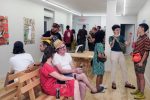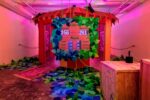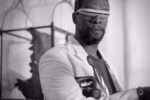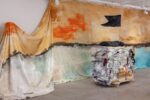Joan Jonas‘ “Reading Dante III” at the Fabric Workshop and Museum includes a 45-minute video of people reading excerpts of Dante’s Divine Comedy. The lengthy, dreamy, stream of consciousness video also shows the artist drawing circles within circles that suggest the poet’s description of Hell and Purgatory. Despite these literal moments, however, Jonas’ installation on the whole is not literal. Rather, it’s lyrical, and in places, beautiful.
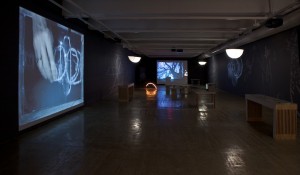
Interested in something other than Dante’s words, the acclaimed New York video and performance pioneer takes the words out of the equation, creating instead a dark cave-like underworld with low light, the rumble and tinkle of sound and ambiguous repetitive motions on three video projections. Vitrines contain the artist’s chalk drawings; light sculptures provide dim light, and benches accommodate the weary.
In the videos, humans recite, sing, play, draw with chalk, climb a wall, walk in circles, drive in circles and parade theatrically behind a scrim that shows them as dark silhouettes. Filmed in Mexico, Canada, New York and Italy, Dante’s journey – minus the religion or words – is translated into an existential void where everything cycles and re-cycles, no beginning or end.
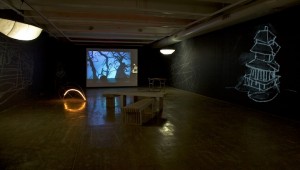
There is no suspense here or suggestion of gothic grotesques. What’s suggested is ordinary humans performing tasks that have no meaning. The world is like ours but patched together and layered via double and triple exposure in a way that makes it seem just beyond the doors of perception. This is slow art. And, for all the 21st Century production values, the piece’s aesthetic suggests the world about 50 years ago, not today.
Like Margaret Meade’s videos of natives of New Guinea, these videos play like scientific transmissions from the great beyond. The Smithsonian has a moon rock in a vitrine; Jonas’ installation has artifacts from her performances in a vitrine. Few will experience a trip to the moon first-hand. And relatively few have seen Jonas’ performances. But we can imagine both while viewing the documentation in a darkened and dreamy space.
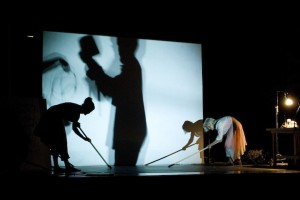
I struggled to hear Dante’s words, which are read repeatedly in the 45-minute video projection. The voices echo in the huge gallery space and will not clarify. I wondered if this was intentional. A 4-page handout of the words featured from the Divine Comedy gives a sense of Dante’s gruesome and graphic aesthetic – “a gloomy wood…death might well be its confederate… the wasteland…terrible crescendo…where light was not…children crying in their sleep…unhappy flesh…as they lay dead…absolute rock bottom.”
What Jonas offers, instead, is a series of disparate and seemingly hum drum moments that add up to an existential nothingness. Perhaps for us Post-moderns, contemplating the void on earth is far more terrifying than contemplating Dante’s vision of the afterlife.
Jonas (b. 1936) graduated from Columbia University, where she studied sculpture and art history. But she discovered a love of performing early on and switched to video and performance in the early 70s. As she says in a recorded MoMA interview, video was a new art form at the time and, unlike painting and sculpture, the field was not male-dominated so it gave women a voice in the art world.
Influenced by Surrealism and the sculptures of Alberto Giacometti, Jonas is a great image-maker. Her videos might be long (the 45-minute video could be edited down) and repetitive, but they are punctuated by lovely lyrical passages, including some that translate the film into a negative of itself, a suggestion of death, sickness and the spirit world.
Kara Walker, the artist known for re-imagining the anti-bellum South in cut-paper silhouettes, and William Kentridge, who envisions the evils of apartheid in animated films based on his charcoal drawings, both, like Jonas, use drawings and video to transform historical and literary texts. Each of these artists uses theatrical methods, too, to parade before your eyes a darker truth about the world.
Jonas will perform live at the FWM Dec. 11. Don’t miss this chance to see this seminal artist in person.
“Joan Jonas – Reading Dante III” through Jan. 2011. Live performance of “Reading Dante II” Sat. Dec. 11, 7pm, reception at 6pm. Fabric Workshop and Museum, 1214 Arch St., 215 561 8888. Admission $3 adults
See Jonas talking about feminism in this MoMA video.
Joan Jonas talking about the Dante project at the 2008 Yokahama Triennial.


